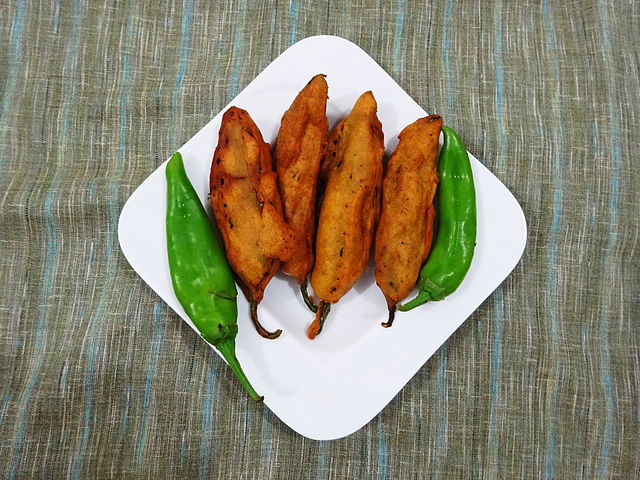Mama’s Punjabi Recipes: Hari Mirch De Pakore (Fried Green Chilli Fritters)
 BY SHAKUNTLA MALHOTRA
BY SHAKUNTLA MALHOTRA
What could be more tempting for the typical Indian palate than fried food and hot, hot chilli pakoras? One thing is for sure, so many Indians love hot, spicy food that there are contests even for the hottest chilllies in the country. Chillies come in many colors – green, purple, yellow, orange – depending on the variety. When dried almost all will turn to red, and have more concentrated sugars and lose their fresh, grassy scent, especially the green ones.
Chillies originated in the West Indies and quickly spread elsewhere. There are about 300 known species of chillies, and they all contain the active ingredient capsaicin which affects the respiratory system, blood pressure and heart. Capsaicin causes the heat that stimulates the palate and increases blood circulation which makes the body sweat, which in turn has a cooling effect. This is why chillies are so dominant in tropical areas.
The flavor and heat levels (indicating the concentration of capsaicin) of different types of chillies is addictive as endorphins are released to deal with the heat. Some chillies produce rapid, sharp sensations at the back of the throat while others ignite a lingering, low-intensity burning on the tongue and middle palate. Generally, the smaller the chilli or thinner the skin, the more intense it will probably be.
The seeds and membranes contain the most capsaicin, a peppery compound produced by ripening chillies to ward off insects that attack the fruit and bush. Capsaicins can spread very easily through casual contact and can burn sensitive skin areas and damage your eyes, so gloves should be worn when cutting chillies. Drinking water will only intensify the burning sensation in your mouth; instead, breathe through your nose and take some salt, milk, yoghurt, cucumber or mint leaves.
Chickpea flour is also called besan and come from dry roasted garbanzos (or chickpeas) which is then ground. Besan is high in carbohydrates, but contains no gluten and has a higher protein content than other flours.
To most people, pakoras (or pakore) are an inexpensive fried snack that combines the flavor of a vegetable, fish or chicken with a spicy batter and is eaten with some chutney, and served mostly as an appetizer. In many Indian cities, it is eaten as a snack, often from a hawker stand on the street corner or from the neighborhood halwai (pastry cook), coming hot, straight from the boiling cauldron.
Ingredients:
• 1.5 cups besan (chickpea flour)
• 1 1/2 cups pani (water), enough to make running paste
• 1 dozen hari mirchi (green chillies)
• 1 tsp dhaniya (coriander) powder
• ½ tsp namak (salt)
• ½ tsp lal mirch (red pepper)
• 1 tsp amchoor (mango powder)
• Spices to taste: namak (salt), lal mirch (red pepper)
Directions:
1. Wash the chillies and then towel dry them. You can leave the stems on.
2. Combine the spice ingredients in a small bowl.
3. Cut a sit lengthwise in each chilli and stuff a small amount of the spices in them and set aside.
4. Mix in namak and mirch into 1.5 cups of besan and water till it becomes a soft, running paste.
5. Heat the oil in a karahi (wok). Throw in a small dab of batter to make sure the oil is very hot. Take a chilli, dip it into the batter to coat it then release it into the hot oil. Keep doing this till the surface of the oil is covered with battered pieces.
6. When one side is slightly brown, turn it over using a sieved spatula and turn over a few times to make sure both sides are cooked. Be careful that they do not become dark brown. Take them out and place on a paper towel to absorb the extra oil.
7. Mirchi pakoras are best when served hot with some tomato ketchup or mint chutney.
MAMA’S TIP OF THE WEEK: DON’T MAKE PAKORAS IN VERY HOT OIL
For most Indians who were brought up in the Old Country, one of the favorite activities on a damp, cool rainy Monsoon day is to have a cup of tea (some prefer masala chai) with straight off the cauldron hot pakoras and samosas. What starts out as a snack soon turns into a full-fledged, stomach filling and satisfying meal over some delightful conversation with friends and family.
But when making the pakoras, be sure to moderate the heat of the oil in the kadai (or wok). If you slide in the battered vegetables in very hot oil, then the pakoras will immediately turn dark brown and will lose their appeal. For best results, make sure the oil is moderately hot by testing with a few drops of batter before.
________________
Shakuntla Malhotra is a skilled cook of Punjabi dishes made in the old-fashioned style that she learnt as a young woman in her ancestral home in Lyallpur, India (since renamed Faisalabad) before it became part of Pakistan after the Partition in 1947. People have often admired her cooking for its simplicity and taste that comes with each mouthful. Even in her early-nineties, she continues to cook daily and agreed to share her delectable Punjabi recipes for future generations.
